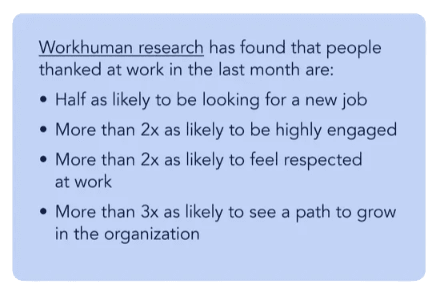5 Ways to Show Gratitude in the Workplace & the Benefits That Come From It
Table of contents
- Why is expressing gratitude in the workplace so important?
- What are the benefits of gratitude in the workplace?
- What happens if gratitude is absent from the workplace?
- Points to consider when showing gratitude at work
- 5 examples of how to show gratitude in the workplace
- Elevating gratitude in the workplace
- FAQs
- Conclusion

A recent studyOpens in a new tab shows that 93% of employees are motivated to do their best work if they feel recognized and appreciated. Showing gratitude in the workplace doesn't just improve personal performance; it can also help improve the team and organizational structure.
As a manager, you want to make sure that your employees are feeling rewarded and content because this will affect the performance of your team and the overall performance of the company.
So, how can you help your employees feel more appreciated? How can you emphasize the importance of gratitude in the workplace? And what are the benefits, overall, of showing gratitude and appreciation?
Keep reading to learn more about this topic, and about how to transform your team into a high-performing one by expressing sincere gratitude and appreciation.
Why is expressing gratitude in the workplace so important?
Showing gratitude in the workplace on a consistent basis is important for a variety of reasons. One of the main things it does is it establishes a connection between employees and it reinforces positive behaviors that fuel the culture of your organization.
Consistent gratitude
Evidence suggests that a consistent gratitude practice can strengthen relationships and have a long-term positive impact.

According to network theories of emotion, emotion schemas develop linearly through repeated pairings of stimuli and emotions.
Meaning, when leadership demonstrates consistent gratitude, and employees experience frequent and intense episodic gratitude within the workplace, employees become more attuned to gratitude-inducing stimuli.
For example, they're more likely to recall helpful advice during challenging times, or view assistance meeting a deadline as worthy of gratitude instead of as you trying to steal the spotlight.
Reduce turnover in younger generations
A recent study showedOpens in a new tab that about 47% of GenZ and 42% of millennial employees feel that they’re not appreciated by their employer and that they’re disposable, compared to only 28% of GenX and 32% of baby boomers.
In this study, it's clear that younger employees are less likely to feel recognized. So, what does this mean?
Unfortunately, this means that younger employees are more likely to look for other jobs or at least not deliver their best performance at work. There are several reasons why this might happen.
- Due to technological advancements, most lower-level jobs are partially automated. For example, a company can invest in a software solution and hire one or two employees to run the tasks of a whole department.
- Companies value experience, so managers might overlook active and promising younger employees. This isn't a threat for someone who has been doing the same job for decades because they have a history to back up their knowledge.
- Most younger employees feel that they’re underpaid, while higher-level managers receive bigger salaries.
- In project work, a manager might take all the credit for the work presented, even if it was executed by their subordinates, who are often left unrecognized and unappreciated.
All of this is to say, showing more gratitude to younger talent is key to employee retention and driving organizational success.
What are the benefits of gratitude in the workplace?
Gratitude in the workplace is about showing employees they’re valued, appreciated, and recognized. The employees feel that their contributions matter, so they’re not just doing their job for a paycheck at the end of the month. They actually feel like a member of a bigger family: the organization.
Creating a positive workplace culture is the responsibility of higher managerial levels. Your job as a manager is to try to find solutions to make your employees feel appreciated and heard. You should also find ways to show gratitude for work done and delivered so your employees know that their efforts aren’t in vain.

Expressing gratitude in the workplace encourages employees to do their best and helps in building strong teams. Employees feel like members of one family, so they’re ready to go above and beyond to do what is best for the company.
Workers need to feel that they’re recognized and appreciated for what they do. This is why showing gratitude for work done is one of the fastest and easiest ways to boost the performance of teams and individual employees.
Employees who are shown gratitude at work are likely to feel better physically and mentally. Studies showOpens in a new tab that people are less likely to feel and express gratitude at work than in any other place. This is why managers should focus on gratitude-promoting activities that can help make employees feel more engaged. Here are some of the benefits of showing gratitude at work:
- Your employees' mental and physical health will improve.
- Employees feel more engaged because of gratitude in the workplace, and they’re more willing to put more effort into the work they do.
- Teams become more cooperative and efficient.
- Conflicts within teams and among employees decrease.
- Employees feel less stressed and become more helpful.
- Productivity increases within the organization as a whole.
- The employees become more loyal and are less likely to look for other jobs.
- Consistent employee recognition leads to an increase in motivation, as employees will think of more efficient ways to get the work done.
- Customers become more satisfied because of improved employee performance.
- Remote teams become more connected to the company.
- Employees become more self-confident and enjoy better self-esteem.
- Work relationships become more like friendships, and people genuinely care about each other.
What happens if gratitude is absent from the workplace?

The lack of gratitude at work will leave employees dissatisfied, unmotivated, unappreciated, and stressed. It can lead to workplace conflicts and affect relationships within teams. It also affects the relationship between managers and their teammates. Here are a few things that can happen.
- Disengaged employees will dread coming to work. They’ll find excuses to skip work because they’re not happy about being at the workplace and this will negatively impact organizational success.
- Employees will take more time to finish assigned tasks, which automatically leads to a decline in productivity. They’re putting in less effort to finish their work because they don’t feel that it matters.
- Unappreciated employees don’t feel they belong at the company, so they’ll spend more time looking for other jobsOpens in a new tab. They might even do this during work hours when they should be focusing on their current tasks and projects. This will lead to delays and decreased performance.
- Employees who don’t feel recognized can sell the company’s secrets which cost it a lot of money. Almost 50% of employeesOpens in a new tab expressed that they would sell confidential data if the price is right, and the percentage increases if they don’t feel that their company appreciates their efforts.
Points to consider when showing gratitude at work
Expressing gratitude at work is essential, but managers might feel confused about the right points to consider. Here are a few points that you shouldn’t miss.
- Set an example by showing gratitude to your team members and praising a job well done, so other managers will follow.
- Show timely gratitude once a job is done. Employees want to feel recognized as soon as the job is done and not weeks later during board meetings.
- Use various ways to show appreciation, depending on the nature of the project, employees, and the organization as a whole.
- Make sure that you understand the differences between people when you’re acknowledging their work. Some employees appreciate public shout-outs, while others might prefer intimate one-to-one meetings to receive positive feedback.
- Be consistent in integrating workplace gratitude into the company’s culture. Show appreciation daily, and ask other managers to do this too.
- Be genuine and compassionate while showing your gratitude at the workplace. Employees need to feel that you really mean what you say.
In Crystalee Webb Beck's studyOpens in a new tab, she points out that,
"Sincerity is highly important to employees, which was found to be indicated by specificity, personalization, timeliness, and equivalency."
5 examples of how to show gratitude in the workplace
Cultivating gratitude is beneficial for employees and the company as a whole, as it helps create stronger and more efficient teams. Since no one wants to work for an ungrateful boss, it's important to find ways to show gratitude at work (and to encourage other managers to follow suit). Here are five ways to show appreciation at work.

Say “thank you”
While this might seem like the easiest way to show recognition, it’s actually the most potent one. People need to hear that their work is appreciated and have their efforts acknowledged.
Saying "thank you” and praising employees on a daily basis improves workplace relationships and puts your employees in a good mood. As a result, those employees have positive emotions, which reflect on their workplace performance.
For example, if an employee or coworker sacrifices their free time to help you meet a deadline, a handwritten note is a great way to show your gratitude.
Offer personal development opportunities
In addition to expressing gratitude and saying “thank you,” offer high-performing employees personal development opportunities. Employees would love to work for a company where there’s an opportunity for growth, and they will be more motivated knowing that their efforts will be appreciated.
Personal development opportunities include courses, networking events, conferences, offering employees special projects that can help them advance in their career, and allowing them to shadow other colleagues while doing certain duties.
Take it outside the office
Building strong relationships between team members can be done inside and outside the office. This is why taking your employees out to celebrate the success of a project and showing gratitude for their efforts is an excellent way to make them feel recognized.
Organizing fun and casual events depends on the nature of the company, teams, and employees involved. Some cultures support family-oriented gatherings, while others prefer formal dinners. You need to understand the culture of your company and what works for your employees to pick a suitable fun activity.
Recognize efforts even when things go wrong
Some projects won’t end the way you wanted them to, but don't assume it's for lack of trying.
It’s important to acknowledge your team's efforts, focus on what they did right, and then ask them for their input. Then, your employees will help identify what went wrong, which can be avoided in the future.
Offer time off
Nothing shows your gratitude for work done than offering hardworking employees time off. Employees might be stressed to ask for time off when they’re working hard, but if a manager tells them that it’s time to take a break, they’ll feel highly appreciated.
As a manager, you can keep an eye on your team members and see if one of them seems drained. Genuinely offering time off will boost your employee’s confidence, and they will return to work feeling refreshed and eager to work.
Sacrifice your free time
Sacrificing your free time to help a coworker meet a deadline is a great way to show gratitude. This is a form of episodic gratitudeOpens in a new tab, where the "perceived benevolence and sacrifice of the benefactor play critical roles." Meaning, their interpretation of the situation is where the positive impact comes into play because you helped when you didn't have to.
Elevating gratitude in the workplace
So you’ve found five new ways to express gratitude at work – now how do you elevate a culture of gratitude?
Just like any other cultural pillar, change starts at the top. Ensure leadership and managers are all bought into the importance of showing gratitude at work. Train them on how to extend gratitude to their team members, as well as how to encourage their peers and employees to do the same.
As you can tell by now, it’s a lot more than just “thank you.” It’s ensuring employees know why they’re appreciated and taking extra steps on a regular basis to show that appreciation.
You don’t get these benefits from a one-off note or outing. Gratitude is a practice that requires consistent effort. Show your employees your appreciation by showing up and being present time and again.
FAQs
How do you professionally express gratitude?
There are several ways to say “thank you” professionally.
- I appreciate your insight and the information you shared.
- I’m thankful for your time and effort.
- Your assistance is appreciated.
- This project wouldn’t have succeeded without your precious contribution.
Why is appreciation so important at work?
Showing appreciation to coworkers and subordinates makes them feel appreciated, seen, and recognized. They feel like members of a family, and they will work harder to make things work. Appreciation also strengthens relationships within teams to improve productivity.
Conclusion
Practicing gratitude in the workplace is one of the easiest and most important ways to build strong teams within a company. Employees will feel recognized, appreciated, and seen, and they will feel more connected to the company.
Tell us in the comments about the most efficient way of making your employees feel valued and how this works for them.
Discover how Social Recognition® and the rest of the Workhuman Platform can transform your organization’s culture into one with gratitude at the center.